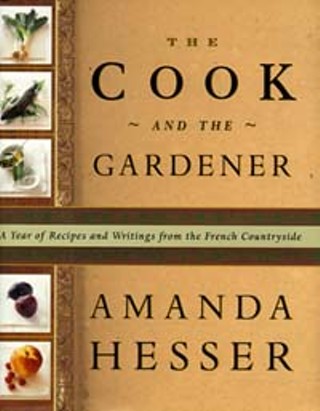Cookbook Reviews
Eating Between the Lines
By Rebecca Chastenet dé Gery, Fri., Dec. 31, 1999

The Cook and The Gardener:
A Year of Recipes and Writings From the French Countrysideby Amanda Hesser
Norton, 632 pp., $32.50
I can't help it. Every time I read about author Amanda Hesser's muse, Monsieur Milbert, I envision Chancey the Gardener from the movie Being There. Milbert is the inspiration for Hesser's cookbook/chef's journal The Cook and The Gardener. Admittedly, with his Gallic demeanor (Monsieur Milbert talks through the hand-rolled cigarettes pressed between his lips and shrugs off foreigners' attempts at conversation), Milbert has little in common with the mild-mannered Chancey. But both men "garden a blue streak," Chancey with his seasonal flowers and Monsieur Milbert with his prodigious vegetable garden tucked behind a 17th-century chateau in Burgundy.
The Cook and The Gardener: A Year of Recipes and Writings for the French Countryside by New York Times food writer Amanda Hesser is a seasonal tribute to the symbiotic relationship of a chef and her provider of ingredients. It is an autobiographical account of Hesser's experience working as a private cook for Anne Willan, owner of the celebrated Ecole de Cuisine La Varenne, and of her evolving friendship with the daunting French gardener Monsieur Milbert, punctuated by simple recipes categorized by month. As Hesser explains in her introduction, "I had been warned to be polite when making my daily request for vegetables, and to avoid (Monsieur Milbert) whenever possible. He was a coarse and unpleasant old man -- Monsieur Milbert, the gardener, and I, the cook, had direct connections to the garden. I needed to know what was going on within those walls -- I wanted to know why thyme's intensity fluctuated, why the leeks sweetened with age, when the raspberries would be at their peak. And there was something else too. There was more to that old man than his gruff manner and questionable reputation."
As the months pass, Hesser and Milbert go from being respectful strangers to mutually admiring acquaintances. Their relationship is tentative and subtle; their exchanges make for witty, insightful chapter introductions. There are no photographs in The Cook and the Gardener, but Hesser's frank writing style is full of images. Through her prose, readers are offered glimpses of life in the French countryside. There are scenes of collecting chestnuts, harvesting potatoes, shopping at the local market. Most of the time, Hesser delivers commentary on her life with the French locals in an even-handed, tell-it-like-it-is manner. Occasionally, though, she falls into what I call the "Peter Mayle trap," characterizing the French country folk in a patronizing, "aren't they charming" way.
In the November chapter, for example, Hesser uses a break down of Monsieur Milbert's apple press to relate that, "In France, whatever the crisis, be it a labor strike or a broken door knob, there is an intricate chain of events that must take place before things can move forward again. The problem must first be analyzed by at least two people with contrasting opinions. Then a third party is roped in to confuse matters more. Several impractical solutions are proposed, and if it involves anything mechanical, the chosen solution inevitably involves a trip to the Bricomarche, the Frenchman's playground. Undoubtedly, this is what held up cider production for the next week." Given his cynical nature, Hesser's Monsieur Milbert might agree with -- even laugh at -- Hesser's explanation. But he might also claim that the dig was "gratuit," (dealt way too freely) by a young American who fails to appreciate the social intricacies of another society.
As for the recipes in The Cook and the Gardener, Hesser creates both classic and creative dishes with Monsieur Milbert's produce. Her recipe introductions are crammed with information -- historical, practical, and contextual, and her cooking instructions are clear and concise. Serving suggestions follow each recipe and include menu planning ideas and detailed presentation tips. Hesser also frequently offers shopping and storing advice for vegetables and gives great tips on the handling of ingredients.
A cookbook that reads like a book, The Cook and the Gardener is a food tome that will probably spend more time on the bedside table than in the kitchen. It's a light read, offering a perfect "late night" get-away that will get you to dreaming about food, if not fixing it.








